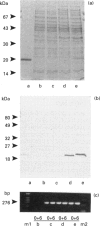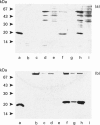Abstract
The platelet aggregation inhibitor pallidipin is a protein present in the saliva of the blood-sucking triatomine bug Triatoma pallidipennis. Expression of recombinant pallidipin in the periplasm of Escherichia coli was achieved by placing its coding sequence downstream of the alkaline phosphatase (APase) or trc promoter in frame with bacterial leader peptide DNA sequences derived from APase or from the periplasmic form of cyclophilin (Cph). In each case the DNA sequence of mature pallidipin was merged to the leader peptide coding part, either directly, or while introducing additional amino acids, in order to assess their influence on the activity of the leader peptidase and on the biological activity of the recombinant protein. All tested constructs gave rise to abundant periplasmic expression of pallidipin, which was then purified by a combination of cation- and anion-exchange chromatography followed by size-exclusion gel chromatography. Recombinant pallidipin had the expected molecular mass (approximately 19 kDa) and was correctly processed, as demonstrated by SDS/PAGE and N-terminal amino acid sequencing. The highest expression levels were obtained with the three APase-derived expression plasmids. Platelet aggregation tests revealed that E. coli-derived pallidipin was fully active, with an IC50 of 33-89 nM, comparable with that of the native protein, except when an additional N-terminal lysyl-isoleucyl dipeptide was present, which resulted in an IC50 more than ten times higher.
Full text
PDF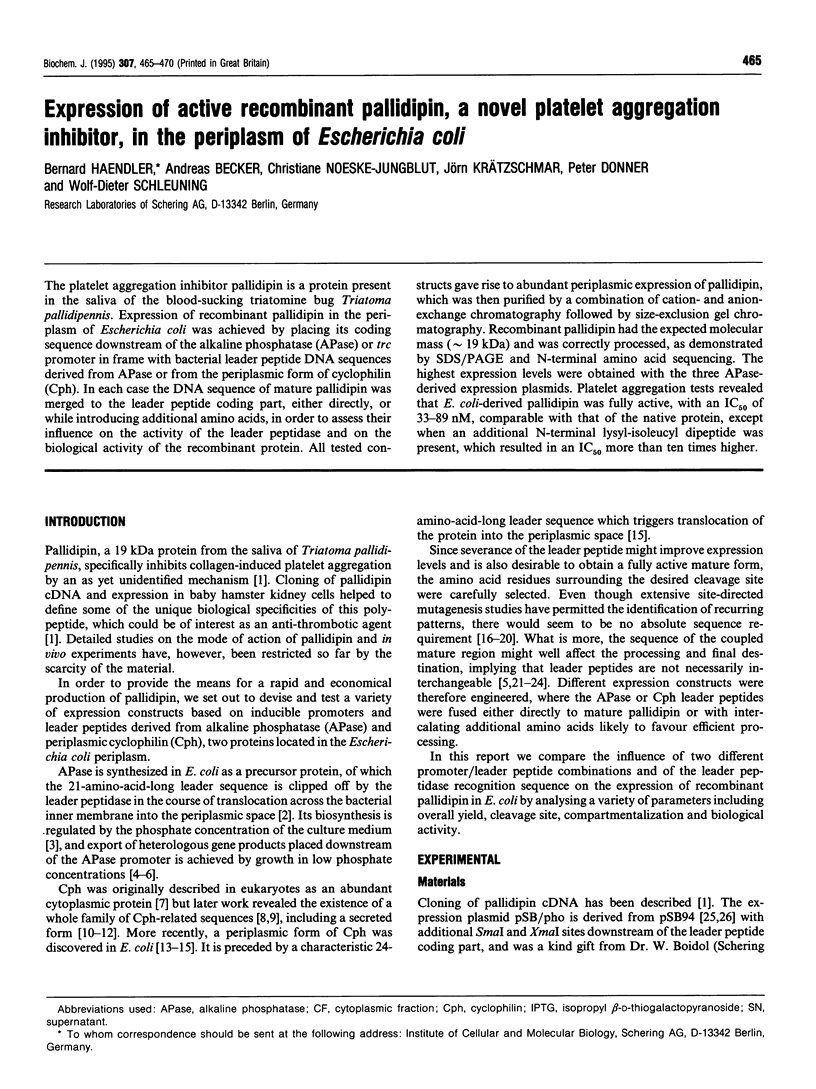
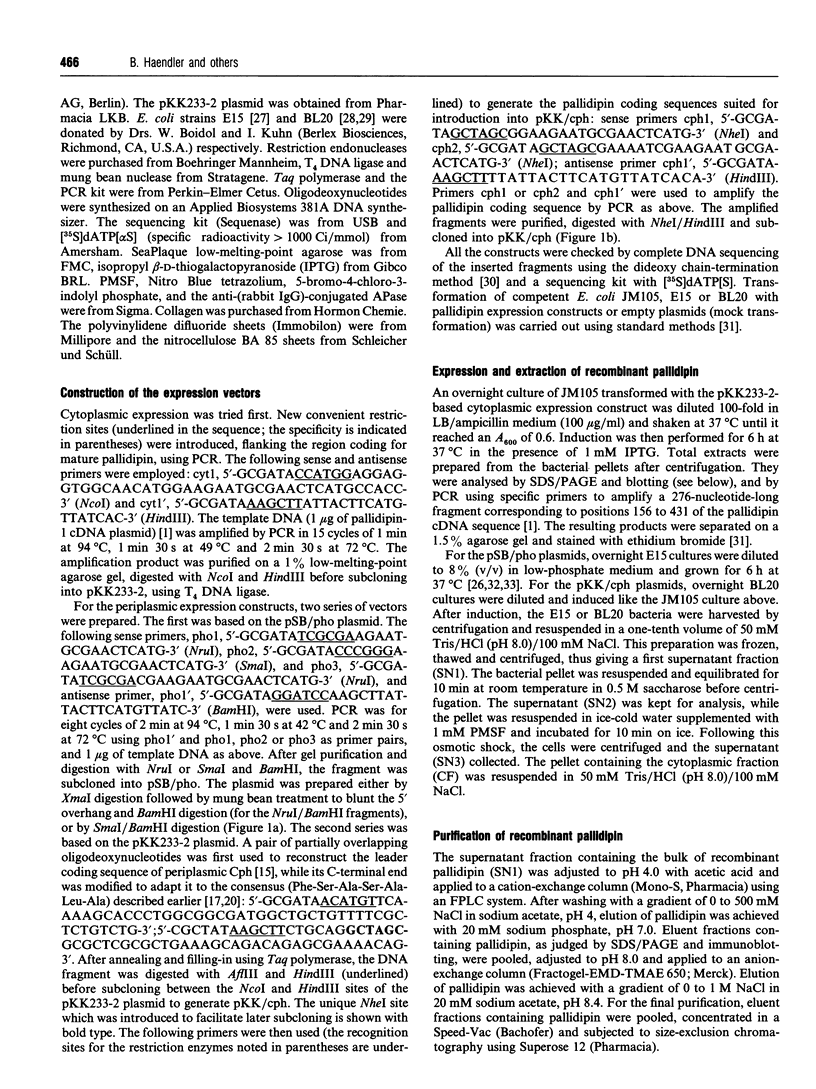
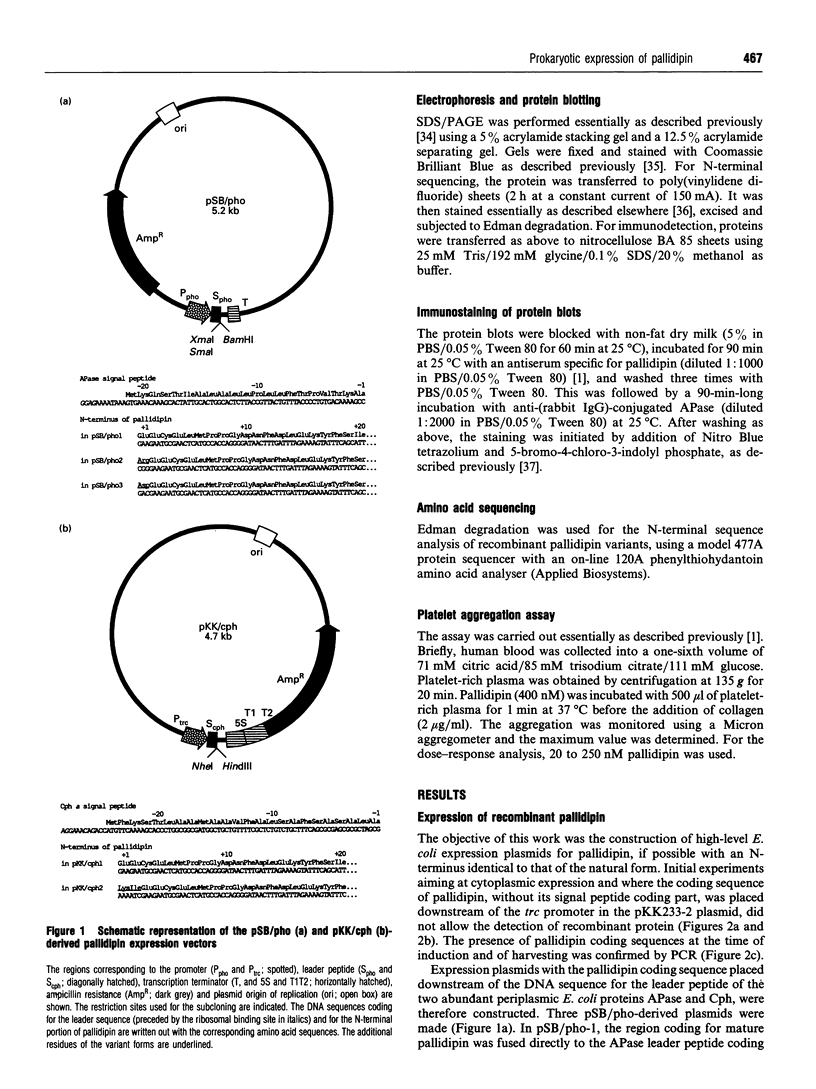
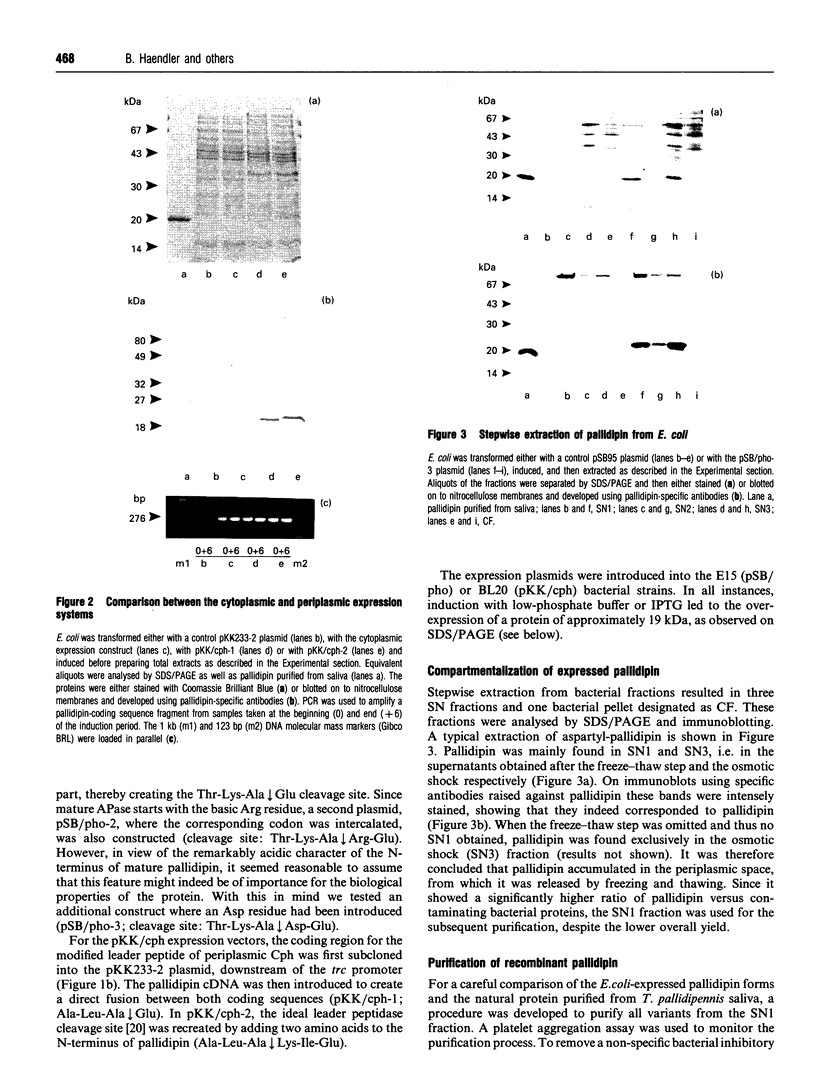
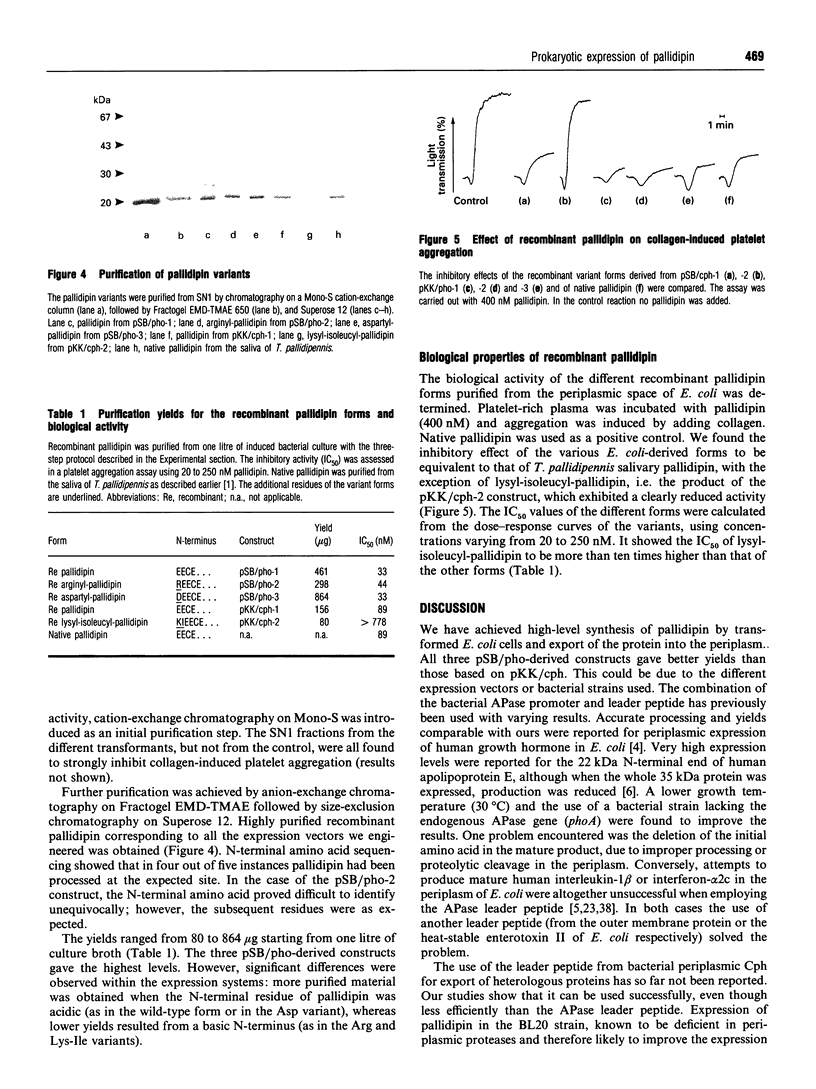
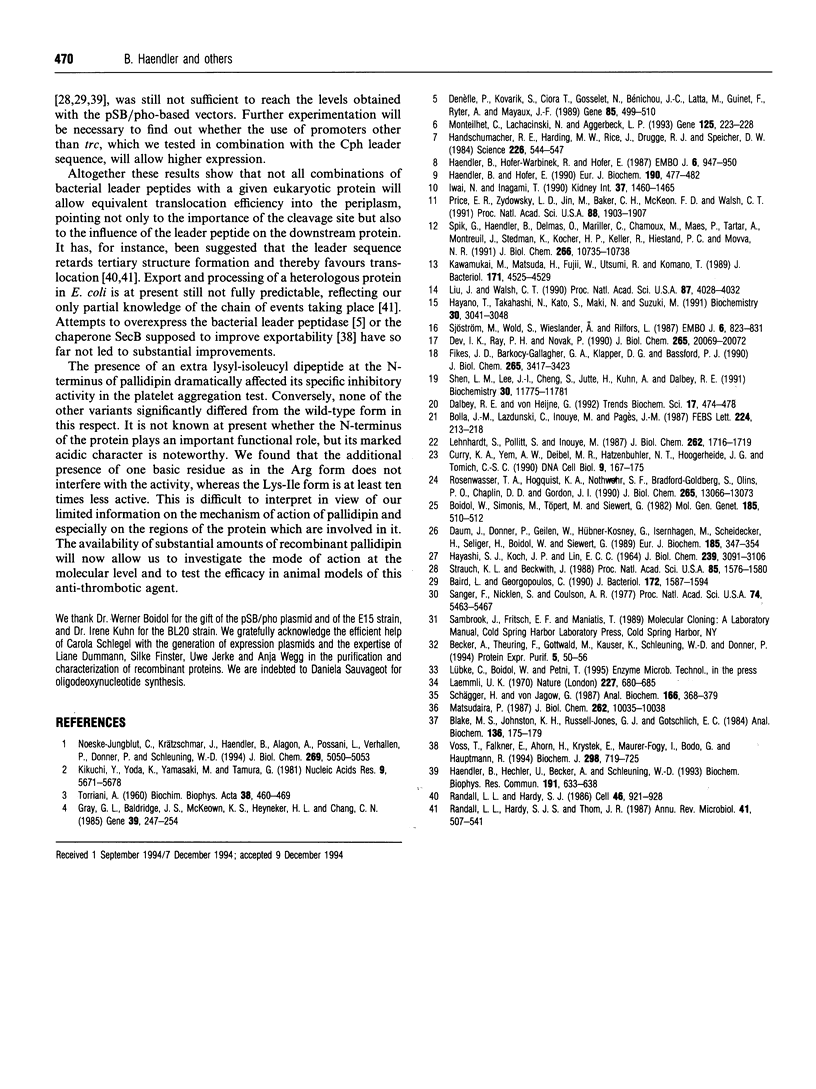
Images in this article
Selected References
These references are in PubMed. This may not be the complete list of references from this article.
- Baird L., Georgopoulos C. Identification, cloning, and characterization of the Escherichia coli sohA gene, a suppressor of the htrA (degP) null phenotype. J Bacteriol. 1990 Mar;172(3):1587–1594. doi: 10.1128/jb.172.3.1587-1594.1990. [DOI] [PMC free article] [PubMed] [Google Scholar]
- Becker A., Theuring F., Gottwald M., Kauser K., Schleuning W. D., Donner P. Purification of human big endothelin 1 derived through cleavage with collagenase and dipeptidylpeptidase IV from a fusion protein expressed in Escherichia coli. Protein Expr Purif. 1994 Feb;5(1):50–56. doi: 10.1006/prep.1994.1007. [DOI] [PubMed] [Google Scholar]
- Blake M. S., Johnston K. H., Russell-Jones G. J., Gotschlich E. C. A rapid, sensitive method for detection of alkaline phosphatase-conjugated anti-antibody on Western blots. Anal Biochem. 1984 Jan;136(1):175–179. doi: 10.1016/0003-2697(84)90320-8. [DOI] [PubMed] [Google Scholar]
- Boidol W., Simonis M., Töpert M., Siewert G. Recombinant plasmids with genes for the biosynthesis of alkaline phosphatase of Escherichia coli. Mol Gen Genet. 1982;185(3):510–512. doi: 10.1007/BF00334150. [DOI] [PubMed] [Google Scholar]
- Bolla J. M., Lazdunski C., Inouye M., Pagès J. M. Export and secretion of overproduced OmpA-beta-lactamase in Escherichia coli. FEBS Lett. 1987 Nov 16;224(1):213–218. doi: 10.1016/0014-5793(87)80450-7. [DOI] [PubMed] [Google Scholar]
- Curry K. A., Yem A. W., Deibel M. R., Jr, Hatzenbuhler N. T., Hoogerheide J. G., Tomich C. S. Escherichia coli expression and processing of human interleukin-1 beta fused to signal peptides. DNA Cell Biol. 1990 Apr;9(3):167–175. doi: 10.1089/dna.1990.9.167. [DOI] [PubMed] [Google Scholar]
- Dalbey R. E., Von Heijne G. Signal peptidases in prokaryotes and eukaryotes--a new protease family. Trends Biochem Sci. 1992 Nov;17(11):474–478. doi: 10.1016/0968-0004(92)90492-r. [DOI] [PubMed] [Google Scholar]
- Daum J., Donner P., Geilen W., Hübner-Kosney G., Isernhagen M., Scheidecker H., Seliger H., Boidol W., Siewert G. Production of human adrenocorticotropin by cleavage of alkaline-phosphatase-derived fusion proteins containing repetitive recognition sequences for collagenases. Eur J Biochem. 1989 Nov 6;185(2):347–354. doi: 10.1111/j.1432-1033.1989.tb15122.x. [DOI] [PubMed] [Google Scholar]
- Denèfle P., Kovarik S., Ciora T., Gosselet N., Bénichou J. C., Latta M., Guinet F., Ryter A., Mayaux J. F. Heterologous protein export in Escherichia coli: influence of bacterial signal peptides on the export of human interleukin 1 beta. Gene. 1989 Dec 28;85(2):499–510. doi: 10.1016/0378-1119(89)90444-7. [DOI] [PubMed] [Google Scholar]
- Dev I. K., Ray P. H., Novak P. Minimum substrate sequence for signal peptidase I of Escherichia coli. J Biol Chem. 1990 Nov 25;265(33):20069–20072. [PubMed] [Google Scholar]
- Fikes J. D., Barkocy-Gallagher G. A., Klapper D. G., Bassford P. J., Jr Maturation of Escherichia coli maltose-binding protein by signal peptidase I in vivo. Sequence requirements for efficient processing and demonstration of an alternate cleavage site. J Biol Chem. 1990 Feb 25;265(6):3417–3423. [PubMed] [Google Scholar]
- Gray G. L., Baldridge J. S., McKeown K. S., Heyneker H. L., Chang C. N. Periplasmic production of correctly processed human growth hormone in Escherichia coli: natural and bacterial signal sequences are interchangeable. Gene. 1985;39(2-3):247–254. doi: 10.1016/0378-1119(85)90319-1. [DOI] [PubMed] [Google Scholar]
- Haendler B., Hechler U., Becker A., Schleuning W. D. Expression of human endothelin receptor ETB by Escherichia coli transformants. Biochem Biophys Res Commun. 1993 Mar 15;191(2):633–638. doi: 10.1006/bbrc.1993.1264. [DOI] [PubMed] [Google Scholar]
- Haendler B., Hofer-Warbinek R., Hofer E. Complementary DNA for human T-cell cyclophilin. EMBO J. 1987 Apr;6(4):947–950. doi: 10.1002/j.1460-2075.1987.tb04843.x. [DOI] [PMC free article] [PubMed] [Google Scholar]
- Haendler B., Hofer E. Characterization of the human cyclophilin gene and of related processed pseudogenes. Eur J Biochem. 1990 Jul 5;190(3):477–482. doi: 10.1111/j.1432-1033.1990.tb15598.x. [DOI] [PubMed] [Google Scholar]
- Handschumacher R. E., Harding M. W., Rice J., Drugge R. J., Speicher D. W. Cyclophilin: a specific cytosolic binding protein for cyclosporin A. Science. 1984 Nov 2;226(4674):544–547. doi: 10.1126/science.6238408. [DOI] [PubMed] [Google Scholar]
- Hayano T., Takahashi N., Kato S., Maki N., Suzuki M. Two distinct forms of peptidylprolyl-cis-trans-isomerase are expressed separately in periplasmic and cytoplasmic compartments of Escherichia coli cells. Biochemistry. 1991 Mar 26;30(12):3041–3048. doi: 10.1021/bi00226a009. [DOI] [PubMed] [Google Scholar]
- Iwai N., Inagami T. Molecular cloning of a complementary DNA to rat cyclophilin-like protein mRNA. Kidney Int. 1990 Jun;37(6):1460–1465. doi: 10.1038/ki.1990.136. [DOI] [PubMed] [Google Scholar]
- KOCH J. P., HAYASHI S., LIN E. C. THE CONTROL OF DISSIMILATION OF GLYCEROL AND L-ALPHA-GLYCEROPHOSPHATE IN ESCHERICHIA COLI. J Biol Chem. 1964 Sep;239:3106–3108. [PubMed] [Google Scholar]
- Kawamukai M., Matsuda H., Fujii W., Utsumi R., Komano T. Nucleotide sequences of fic and fic-1 genes involved in cell filamentation induced by cyclic AMP in Escherichia coli. J Bacteriol. 1989 Aug;171(8):4525–4529. doi: 10.1128/jb.171.8.4525-4529.1989. [DOI] [PMC free article] [PubMed] [Google Scholar]
- Kikuchi Y., Yoda K., Yamasaki M., Tamura G. The nucleotide sequence of the promoter and the amino-terminal region of alkaline phosphatase structural gene (phoA) of Escherichia coli. Nucleic Acids Res. 1981 Nov 11;9(21):5671–5678. doi: 10.1093/nar/9.21.5671. [DOI] [PMC free article] [PubMed] [Google Scholar]
- Laemmli U. K. Cleavage of structural proteins during the assembly of the head of bacteriophage T4. Nature. 1970 Aug 15;227(5259):680–685. doi: 10.1038/227680a0. [DOI] [PubMed] [Google Scholar]
- Lehnhardt S., Pollitt S., Inouye M. The differential effect on two hybrid proteins of deletion mutations within the hydrophobic region of the Escherichia coli OmpA signal peptide. J Biol Chem. 1987 Feb 5;262(4):1716–1719. [PubMed] [Google Scholar]
- Liu J., Walsh C. T. Peptidyl-prolyl cis-trans-isomerase from Escherichia coli: a periplasmic homolog of cyclophilin that is not inhibited by cyclosporin A. Proc Natl Acad Sci U S A. 1990 Jun;87(11):4028–4032. doi: 10.1073/pnas.87.11.4028. [DOI] [PMC free article] [PubMed] [Google Scholar]
- Matsudaira P. Sequence from picomole quantities of proteins electroblotted onto polyvinylidene difluoride membranes. J Biol Chem. 1987 Jul 25;262(21):10035–10038. [PubMed] [Google Scholar]
- Monteilhet C., Lachacinski N., Aggerbeck L. P. Cytoplasmic and periplasmic production of human apolipoprotein E in Escherichia coli using natural and bacterial signal peptides. Gene. 1993 Mar 30;125(2):223–228. doi: 10.1016/0378-1119(93)90333-x. [DOI] [PubMed] [Google Scholar]
- Noeske-Jungblut C., Krätzschmar J., Haendler B., Alagon A., Possani L., Verhallen P., Donner P., Schleuning W. D. An inhibitor of collagen-induced platelet aggregation from the saliva of Triatoma pallidipennis. J Biol Chem. 1994 Feb 18;269(7):5050–5053. [PubMed] [Google Scholar]
- Price E. R., Zydowsky L. D., Jin M. J., Baker C. H., McKeon F. D., Walsh C. T. Human cyclophilin B: a second cyclophilin gene encodes a peptidyl-prolyl isomerase with a signal sequence. Proc Natl Acad Sci U S A. 1991 Mar 1;88(5):1903–1907. doi: 10.1073/pnas.88.5.1903. [DOI] [PMC free article] [PubMed] [Google Scholar]
- Randall L. L., Hardy S. J. Correlation of competence for export with lack of tertiary structure of the mature species: a study in vivo of maltose-binding protein in E. coli. Cell. 1986 Sep 12;46(6):921–928. doi: 10.1016/0092-8674(86)90074-7. [DOI] [PubMed] [Google Scholar]
- Randall L. L., Hardy S. J., Thom J. R. Export of protein: a biochemical view. Annu Rev Microbiol. 1987;41:507–541. doi: 10.1146/annurev.mi.41.100187.002451. [DOI] [PubMed] [Google Scholar]
- Rosenwasser T. A., Hogquist K. A., Nothwehr S. F., Bradford-Goldberg S., Olins P. O., Chaplin D. D., Gordon J. I. Compartmentalization of mammalian proteins produced in Escherichia coli. J Biol Chem. 1990 Aug 5;265(22):13066–13073. [PubMed] [Google Scholar]
- Sanger F., Nicklen S., Coulson A. R. DNA sequencing with chain-terminating inhibitors. Proc Natl Acad Sci U S A. 1977 Dec;74(12):5463–5467. doi: 10.1073/pnas.74.12.5463. [DOI] [PMC free article] [PubMed] [Google Scholar]
- Schägger H., von Jagow G. Tricine-sodium dodecyl sulfate-polyacrylamide gel electrophoresis for the separation of proteins in the range from 1 to 100 kDa. Anal Biochem. 1987 Nov 1;166(2):368–379. doi: 10.1016/0003-2697(87)90587-2. [DOI] [PubMed] [Google Scholar]
- Shen L. M., Lee J. I., Cheng S. Y., Jutte H., Kuhn A., Dalbey R. E. Use of site-directed mutagenesis to define the limits of sequence variation tolerated for processing of the M13 procoat protein by the Escherichia coli leader peptidase. Biochemistry. 1991 Dec 24;30(51):11775–11781. doi: 10.1021/bi00115a006. [DOI] [PubMed] [Google Scholar]
- Sjöström M., Wold S., Wieslander A., Rilfors L. Signal peptide amino acid sequences in Escherichia coli contain information related to final protein localization. A multivariate data analysis. EMBO J. 1987 Mar;6(3):823–831. doi: 10.1002/j.1460-2075.1987.tb04825.x. [DOI] [PMC free article] [PubMed] [Google Scholar]
- Spik G., Haendler B., Delmas O., Mariller C., Chamoux M., Maes P., Tartar A., Montreuil J., Stedman K., Kocher H. P. A novel secreted cyclophilin-like protein (SCYLP). J Biol Chem. 1991 Jun 15;266(17):10735–10738. [PubMed] [Google Scholar]
- Strauch K. L., Beckwith J. An Escherichia coli mutation preventing degradation of abnormal periplasmic proteins. Proc Natl Acad Sci U S A. 1988 Mar;85(5):1576–1580. doi: 10.1073/pnas.85.5.1576. [DOI] [PMC free article] [PubMed] [Google Scholar]
- TORRIANI A. Influence of inorganic phosphate in the formation of phosphatases by Escherichia coli. Biochim Biophys Acta. 1960 Mar 11;38:460–469. doi: 10.1016/0006-3002(60)91281-6. [DOI] [PubMed] [Google Scholar]
- Voss T., Falkner E., Ahorn H., Krystek E., Maurer-Fogy I., Bodo G., Hauptmann R. Periplasmic expression of human interferon-alpha 2c in Escherichia coli results in a correctly folded molecule. Biochem J. 1994 Mar 15;298(Pt 3):719–725. doi: 10.1042/bj2980719. [DOI] [PMC free article] [PubMed] [Google Scholar]



